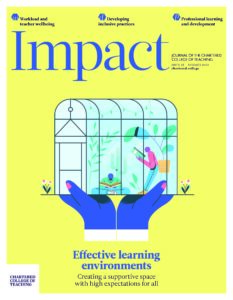Might instructional coaching be particularly helpful in supporting teachers to create an effective learning environment?

Kyle Bailey, Head of Programmes and Partnerships, Ark Teaching School Hub, UK
Matt Dunne, Director of Teaching School Hub, Ark Teaching School Hub, UK
At both Ark and the Ark Teaching School Hub, coaching is at the heart of the work we do. We believe that it can have a transformational impact on our leaders, teachers and students. As a network, we train hundreds of teachers each year in instructional coaching.
We are aware that coaching can come in many forms. We agree with Sims et al. (2021) that it is important to focus not just on the ‘forms’ (a set of characteristics – typical, identifying features; Sims et al., 2021) but also the mechanisms (‘entities and activities organized in such a way that they are responsible for the phenomenon’; Illari and Williamson, 2012, p. 14) that sit behind coaching. Sims et al. (2021) define coaching as:
- Goal setting: Coaches and/or coachees identify specific, focused areas of improvement for coachees
- Feedback: Coaches provide feedback following observations of coachee practice
- Instruction OR modelling: Coaches point coachees toward specific improvements in practice
- Rehearsal OR context-specific repetition: Instructional coaching always involves deliberate practice of new techniques, outside or inside the classroom.
A growing body of research suggests that coaching might be particularly effective in supporting teachers to create positive learning environments (Cohen et al., 2020b). In contrast to instructional coaching, Cohen et al. (2020b) found that teachers randomly assigned to a ‘reflection’ group, who did not receive the directive coaching feedback, not only did not improve their behaviour management, but also had their perceptions of pupils worsen following the sessions.
It is important to not overstate the evidence base for instructional coaching and be cautious about when and how it is implemented. While numerous randomised control trials (RCTs) involving coaching have demonstrated improvements to teachers’ behaviour-management strategies (Allen et al., 2011; Cohen et al., 2020b; Reddy et al., 2021), the evidence base isn’t uniform in its findings for strategies in other areas. For example, there are inconsistencies in the degree to which ‘instructional strategies’ (things like giving concept summaries or academic corrective feedback) lend themselves to coaching (Fabiano, 2018).
The reasons for this discrepancy might be due to numerous factors. A coaching focus on behaviour management and creating a positive learning environment might be:
- easier to define, identify and agree upon
- easier to see
- more readily transferable
- quicker in gains for teachers.
Easier to define, identify and agree upon
For coaching to occur, coaches and/or coachees identify specific, focused areas of improvement (Sims et al., 2021). Teachers need common language to discuss their goals and strategies. This aligns with much of the research around the benefits of deliberate practice in teacher education, which ‘requires setting goals that are well-defined, specific, and measurable’ (Deans for Impact, 2016, p. 6). The phrase ‘deliberate practice’, according to Deans for Impact, is used to refer to activities meant to improve teaching, and is practice that is purposeful and designed to maximise improvement.
Easier to see
Findings vary as to how many lesson observations are necessary to make a somewhat reliable (0.7) holistic judgement on teacher quality (Praetorius et al., 2014). Hill et al. (2012) suggest that if looking at three dimensions under investigation, three lessons per teacher, rated by two raters, were necessary for a reliable estimation of teaching quality. Newton et al. (2010), however, found that the lowest number of lesson observations required for reliable judgements was 20.
For some areas in behaviour management, this number might in fact be just one (Praetorius et al., 2014). The reliabilityIn assessment, the degree to which the outcome of a particular assessment would be consistent – for example, if it were marked by a different marker or taken again ratings might not be high enough to make high-stakes decisions (we don’t believe in grading lessons); but for the purposes of coaching, however, where teachers are being supported to develop in a low-stakes manner, one lesson might be sufficient to identify an appropriate gap that the teacher can be coached to close.
More readily transferable
Some evidence appears to suggest that measures of climate (both positive and negative) and behaviour management appear to be most consistent across subjects for primary-level teachers, but areas like instructional support, including analysis and problem-solving, quality of feedback, content understanding and instructional dialogue, are far less consistent (Cohen et al., 2018).
Evidence also seems to suggest that the consistency of instructional strategies differs within secondary settings. One study found that among English teachers, instructional quality appears lower in writing than in other observations (Grossman et al., 2013), even when controlling for teacher ability.
Even within subjects, and in domains within subjects, questions arise over the applicability of instructional strategies for the same content. Praetorius et al. (2014) question whether instructional strategies might be less prevalent in some lessons depending on the purpose of the lesson; for example, the authors contrast a lesson where students are first introduced to a new topic, to one in which skill automatisation is of most interest. In other words, a teacher might have mastered a skill, but just isn’t given the opportunity to demonstrate it because of the context of the lesson.
Quicker in gains for teachers
Lastly, it also appears that coaching on behavioural strategies might be quicker and achieved in fewer coaching sessions. In the coaching sessions in Cohen et al.’s study (2020b), teachers achieved gains after only three coaching sessions. This stands in contrast with some studies showing no impact of four coaching sessions on instructional strategies (Fabiano et al., 2018).
A more recent randomised controlled trial (RCT) by Reddy et al. (2021) found that both behaviour and instructional strategies produced statistically significant improvements. The authors speculate that the increased number of coaching sessions might be a contributing factor. Reddy et al. (2021) state: ‘It is possible that more coaching (eight versus four sessions) may have bolstered the amount of encouragement, modelling, practice, and performance feedback provided which helped impact both instruction and behaviour management competencies.’ (Reddy et al., 2021, p. 163)
Our way forward
A growing body of evidence seems to suggest that instructional coaching on classroom climateThe social, emotional, intellectual and physical environment of a classroom, organisation and behaviour management might be easier to see, easier to coach on and quicker in the gains for teachers.
That’s not to say that the mechanisms within instructional coaching can’t have gains across other areas of teaching as well.
At Ark and the Ark Teaching School Hub, we draw on the work of Uncommon Schools, a successful charter organisation in the north-eastern United States, and the Relay Graduate School of Education. We adapted the work of Paul Bambrick-Santoyo, Chief Schools Officer for Uncommon Schools and the Founder and Dean of the Leverage Leadership Institute, and across our network we utilise the ‘See It-Name It-Do It’ model (see Figure 1) advocated in his book Get Better Faster (2016).

Every coach at Ark has been trained in ‘See It-Name It-Do It’; as mentioned, we train hundreds of teachers each year to develop their instructional coaching practice. Our training within our schools ensures that teachers are given the requisite knowledge for the instructional approaches coached on. Recent research seems to back this up – one recent RCT (Cohen et al., 2021) found that where knowledge of instructional strategies isn’t present, coaching has no impact. While we believe that the coaching model helps to support many of the mechanisms in Sims et al.’s study (2021) to do with ‘developing teaching strategies’ and ‘embedding practice’, we believe that its scope and sequence can serve in helping teachers to improve by allowing for clear alignment when ‘setting and agreeing on goals’ and sustained development over time.
In Ark’s schools, we prioritise securing a strong climate for learning. This includes building relationships, supporting students to learn and revisiting school-wide routines. It’s essential that all students are given access to effective learning environments. Once the climate for learning is established, we turn our attention towards coaching on academic rigour, to enhance the conceptual thinking that is taking place in classrooms across our schools.
Securing strong knowledge and application of the ‘See It-Name It-Do It’ observation and feedback model, alongside the use of our adapted scope and sequence of action steps, can lead to strong incremental gains for teachers, spanning from our initial teacher trainees through to our most experienced teachers. However, we recognised that more was needed to support and enable teacher development across Ark, and so we developed the Great Teacher Rubric to provide the framework for this.
The Great Teacher Rubric is divided into four stages of development, which set out the likely progression of a teacher over the course of their career. The first version of the rubric developed out of our SCITT, Ark Teacher Training, as a way in which to develop beginner teachers, but since that first iteration, through research, reflection, testing and dialogue, we have expanded the rubric to describe a more comprehensive pathway for a teacher’s progression to great teaching. In attempts to maintain the rubric’s validityIn assessment, the degree to which a particular assessment measures what it is intended to measure, and the extent to which proposed interpretations and uses are justified and ensure that it reflects the latest research and remains an accurate description of the pathway for a teacher’s development, we have developed a strong training, monitoring and evaluation cycle and quality-assurance processes to assess its use in our schools.
By positioning observation and feedback within our Great Teacher Rubric, and by recognising the differences in content areas, our scope and sequence of action steps also look at how we can ensure that we are clearly defining the more predictable aspects of teaching. Direct observation can help, but sometimes it’s not sufficient. Cohen et al. (2020a, p. 8) state that:
showing up in a classroom and assuming that this is the whole of instructional quality is a little like watching a single play of a football game and assuming that the well-choreographed, synchronized motion on the field was all the result of spontaneous (and remarkable) improvisation. What is hidden from view is all of the careful, thoughtful, and strategic pre-planning that preceded the executed events observed on the field, or in the classroom.
This therefore requires using triangulation to gather data – rather than only using observations of teaching, we also draw on assessments, teacher planning and student work to better understand teachers’ development needs.
The development of our network-wide approaches to instructional coaching through observation and feedback has ensured that that the coaching found in any of our 39 schools is not an isolated act; instead, it is part of a well-thought-out, structured, supported and monitored network-wide approach.
- Allen JP, Pianta RC, Gregory A et al. (2011) An interaction-based approach to enhancing secondary school instruction and student achievement. Science 333(6045): 1034–1037.
- Bambrick-Santoyo P (2016) Get Better Faster: A 90-Day Plan for Coaching New Teachers. Hoboken, NJ: John Wiley & Sons.
- Cohen J, Hutt E, Berlin R et al. (2020a) The change we cannot see: Instructional quality and classroom observation in the era of common core. Educational Policy. DOI: 10.1177/0895904820951114.
- Cohen J, Krishnamachari A and Wong VC (2021) Experimental evidence on the robustness of coaching supports in teacher education. EdWorkingPaper No. 21-468. Available at: www.edworkingpapers.com/sites/default/files/ai21-468.pdf (accessed 25 March 2022).
- Cohen J, Ruzek E and Sandilos L (2018) Does teaching quality cross subjects? Exploring consistency in elementary teacher practice across subjects. AERA Open 4(3): 2332858418794492.
- Cohen J, Wong V, Krishnamachari A et al. (2020b) Teacher coaching in a simulated environment. Educational Evaluation and Policy Analysis 42(2): 208–231.
- Deans for Impact (2016) Practice with purpose: The emerging science of teacher expertise Available at: https://deansforimpact.org/wp-content/uploads/2016/12/Practice-with-Purpose_FOR-PRINT_113016.pdf (accessed 25 March 2022).
- Fabiano GA, Reddy LA and Dudek CM (2018) Teacher coaching supported by formative assessment for improving classroom practices. School Psychology Quarterly 33(2): 293.
- Gitomer D, Bell C, Qi Y et al. (2014) The instructional challenge in improving teaching quality: Lessons from a classroom observation protocol. Teachers College Record 116(6): 1–32.
- Grossman P, Loeb S, Cohen J et al. (2013) Measure for measure: The relationship between measures of instructional practice in middle school English language arts and teachers’ value-added scores. American Journal of Education 119(3): 445–470.
- Hill HC, Charalambous CY and Kraft MA (2012) When rater reliability is not enough: Teacher observation systems and a case for the generalizability study. Educational Researcher 41(2): 56–64.
- Illari PM and Williamson J (2012) What is a mechanism? Thinking about mechanisms across the sciences. European Journal for Philosophy of Science 2(1): 119–135.
- Macnamara BN, Moreau D and Hambrick DZ (2016) The relationship between deliberate practice and performance in sports: A meta-analysis. Perspectives on Psychological Science 11(3): 333–350.
- Newton XA (2010) Developing indicators of classroom practice to evaluate the impact of district mathematics reform initiative: A generalizability analysis. Studies in Educational Evaluation 36(1-2): 1–13.
- Praetorius AK, Pauli C, Reusser K et al. (2014) One lesson is all you need? Stability of instructional quality across lessons. Learning and Instruction 31: 2–12.
- Reddy LA, Shernoff E and Lekwa A (2021) A randomized controlled trial of instructional coaching in high-poverty urban schools: Examining teacher practices and student outcomes. Journal of School Psychology 86: 151–168.
- Sims S, Fletcher-Wood H, O’Mara-Eves A et al. (2021) What are the characteristics of teacher professional development that increase pupil achievement? A systematic review and meta-analysis. Education Endowment Foundation. Available at: https://educationendowmentfoundation.org.uk/education-evidence/evidence-reviews/teacherprofessional-development-characteristics (accessed 25 March 2022).










